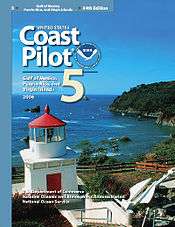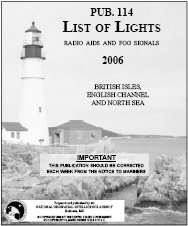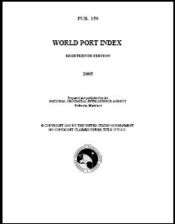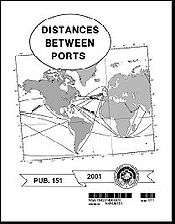Nautical publications
Nautical publications is a technical term used in maritime circles describing a set of publications, generally published by national governments, for use in safe navigation of ships, boats, and similar vessels.
The nature of waterways described by any given nautical publication changes regularly, and a mariner navigating by use of an old or uncorrected publication is courting disaster. Every producer of nautical publications also provides a system to inform mariners of changes that effect the chart. In the United States, corrections and notifications of new editions are provided by various governmental agencies by way of Notice to Mariners, Local Notice to Mariners, Summary of Corrections, and Broadcast Notice to Mariners. Radio broadcasts give advance notice of urgent corrections.
A convenient way to keep track of corrections is with a Chart and Publication Correction Record Card system. Using this system, the navigator does not immediately update every publication in the library when a new Notice to Mariners arrives, instead creating a card for every chart and noting the correction on this card. When the time comes to use the publication, he pulls the publication and its card, and makes the indicated corrections to the publication. This system ensures that every publication is properly corrected prior to use.
Various and diverse methods exist for the correction of electronic nautical publications.
| Image | Description |
|---|---|
 |
The United States Coast Guard Light List is an American navigation publication in 7 volumes made available yearly by the U.S. Coast Guard which gives information on lighted navigation aids, unlighted buoys, radiobeacons, radio direction finder calibration stations, daybeacons, racons, and LORAN stations. |
 |
The American Practical Navigator, written by Nathaniel Bowditch, is an encyclopedia of navigation, valuable handbook on oceanography and meteorology, and contains useful tables and a maritime glossary. In 1866 the copyright and plates were bought by the Hydrographic Office of the United States Navy, and as a U.S. Government publication, it is now available for free online. It is not only a notable book but is considered one of America's nautical institutions. |
 |
United States Coast Pilots is a nine-volume American navigation publication distributed yearly by the National Ocean Service. The purpose of the publication is to supplement nautical charts of U.S. waters. Information comes from field inspections, survey vessels, and various harbor authorities. Maritime officials and pilotage associations provide additional information. Coast Pilots provide more detailed information than Sailing Directions because Sailing Directions are intended exclusively for the oceangoing mariner. Each volume of Coast Pilots must be regularly corrected using Notice to Mariners. |
 |
The List of Lights, Radio Aids, and Fog Signals is a navigation publication produced by the United States Defense Mapping Agency Hydrographic/Topographic Center. The book is usually referred to as the List of Lights, and should not be confused with the U.S. Coast Guard's Light List. The List of Lights is published in seven volumes, as Publication numbers 110 through 116. Each volume contains lights and other aids to navigation that are maintained by or under the authority of other governments. |
 |
Sailing Directions is a 47-volume American navigation publication published by the Defense Mapping Agency Hydrographic/Topographic Center. Sailing Directions consists of 37 Enroute volumes and 10 Planning Guides. Planning Guides describe general features of ocean basins; Enroutes describe features of coastlines, ports, and harbors. Sailing Directions are updated when new data requires extensive revision of an existing text. These data are obtained from several sources, including pilots and Sailing Directions from other countries. |
 |
The World Port Index (PUB 150) contains a tabular listing of thousands of ports throughout the world, describing their location, characteristics, known facilities, and available services. Of particular interest are the applicable volume of Sailing Directions and the number of the harbor chart. The table is arranged geographically, with an alphabetical index. |
 |
Distances Between Ports (PUB 151) is a publication that lists the distances between major ports. Reciprocal distances between two ports may differ due to different routes chosen because of currents and climatic conditions. To reduce the number of listings needed, junction points along major routes are used to consolidate routes converging from different directions. |